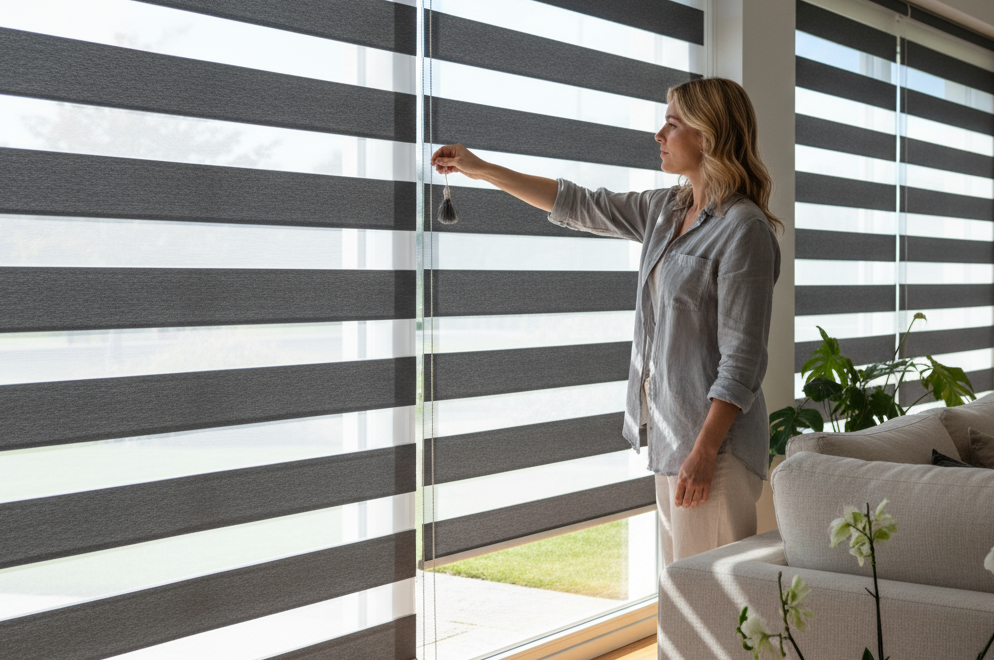If you've been shopping for window treatments lately, you've probably come across something called "zebra shades" and wondered exactly what they are. Despite their exotic name, zebra shades have nothing to do with African wildlife – they're actually one of the most innovative and versatile window treatments available today.
Also known as dual shades, transitional shades, or day-and-night blinds, zebra shades offer a unique solution to the age-old challenge of balancing privacy with natural light. They're called "zebra" shades because of their distinctive striped appearance when partially closed, resembling the alternating light and dark stripes of a zebra.
What makes zebra shades special is their ability to provide precise light control and privacy adjustment in ways that traditional blinds and shades simply can't match. Whether you're looking at zebra shades for your living room or considering them for a whole-home window treatment solution, understanding how they work and what they offer will help you decide if they're right for your space.
How Zebra Shades Work?

The magic of zebra shades lies in their innovative dual-layer design that creates infinite possibilities for light control and privacy. Understanding this mechanism helps explain why they've become so popular among homeowners seeking flexible window treatment solutions.
Dual fabric layers form the foundation of zebra shade functionality. The shade consists of two separate fabric panels, each featuring alternating bands of opaque and translucent material. These panels move independently, allowing you to align the bands in different configurations.
Alternating band structure typically features bands that are 2-4 inches wide, though this varies by manufacturer and style. The opaque bands provide privacy and light blocking, while the translucent bands allow filtered light to pass through when aligned properly.
Sliding mechanism enables the two fabric layers to move past each other vertically. When you operate the shade, you're actually controlling how these two layers align relative to each other, creating different levels of opacity and light filtration.
Three primary positions define zebra shade operation. In the "open" position, translucent bands align to maximize light while maintaining some privacy. The "closed" position aligns opaque bands for maximum privacy and light blocking. The "zebra" position creates the characteristic striped effect with alternating bands.
Infinite adjustment between these positions allows you to fine-tune your light and privacy levels throughout the day. This level of control surpasses what's possible with traditional blinds or standard roller shades.
Smooth operation is achieved through quality hardware systems that ensure the two fabric layers move smoothly and maintain proper alignment. Better systems include features to prevent fabric drift and maintain consistent band alignment over time.
Types and Styles of Zebra Shades

Zebra shades come in various configurations and styles to suit different aesthetic preferences and functional requirements. Understanding these options helps you choose the best type for your specific needs.
Standard zebra shades feature the classic dual-layer design with equal-width alternating bands. These are the most common and versatile option, working well in most residential and commercial applications.
Graduated zebra shades feature bands of varying widths, creating different visual effects and light control patterns. Some designs use narrower bands at the top and wider ones at the bottom, or vice versa, for unique aesthetic appeal.
Textured zebra shades incorporate different fabric textures within the bands themselves. The opaque sections might feature a subtle pattern or texture while the translucent sections remain smooth, adding visual interest even when the shades are in the closed position.
Blackout zebra shades include additional backing material or specially designed opaque bands that block virtually all light when fully closed. These are ideal for bedrooms, media rooms, or any space where complete light control is necessary.
Motorized zebra shades offer the convenience of remote or smart home control, making it easy to adjust light and privacy levels throughout the day. This is particularly valuable for hard-to-reach windows or whole-home automation systems.
Cordless zebra shades eliminate traditional lift cords for safety and clean aesthetics. These systems use spring mechanisms or other cord-free operation methods that are safer for homes with children and pets.
Custom sizing options accommodate virtually any window size or shape, from small bathroom windows to floor-to-ceiling picture windows. Some manufacturers also offer specialty shapes for arched or angled windows.
Benefits of Choosing Zebra Shades
Zebra shades offer several advantages over traditional window treatments, making them attractive options for many homeowners seeking both style and functionality.
Precise light control is perhaps the biggest advantage of zebra shades. Unlike traditional blinds where you're limited to open, closed, or specific slat angles, zebra shades offer infinite adjustment possibilities. You can fine-tune exactly how much light enters your room throughout the day.
Privacy without darkness allows you to maintain privacy while still enjoying natural light. The translucent bands filter light beautifully while preventing clear views into your home, eliminating the all-or-nothing choice between privacy and brightness.
Modern aesthetic appeal makes zebra shades popular in contemporary home design. Their clean lines and innovative functionality complement modern furniture and architectural styles while adding visual interest through their unique striped patterns.
Energy efficiency benefits come from the dual-layer design that provides insulation at windows. The air space between fabric layers helps reduce heat transfer, potentially lowering energy costs for both heating and cooling.
Versatile room compatibility means zebra shades work well in various spaces from bedrooms to offices to living areas. Their adjustability makes them suitable for rooms with different privacy and light control needs throughout the day.
Easy maintenance is another advantage since zebra shades typically require only periodic dusting or light vacuuming. The smooth fabric surfaces don't collect dust like horizontal blinds, and most quality fabrics resist staining and fading.
Child and pet safety is enhanced with cordless operation options that eliminate the strangulation hazards associated with traditional blind cords. This makes zebra shades excellent choices for families with young children or pets.
Zebra Shades vs. Traditional Window Treatments
Understanding how zebra shades compare to other popular window treatments helps clarify when they're the best choice and when alternatives might be more appropriate.
Zebra shades vs. horizontal blinds reveals significant differences in functionality and aesthetics. While horizontal blinds offer angle adjustment for light control, zebra shades provide more precise light filtering without the dust-collecting horizontal surfaces that blinds require.
Zebra shades vs. roller shades shows that standard roller shades offer simplicity but limited light control options – they're basically up or down. Zebra shades provide the clean look of roller shades with dramatically enhanced light control capabilities.
Zebra shades vs. cellular shades demonstrates different approaches to insulation and light control. Cellular shades offer superior insulation but limited light control options, while zebra shades provide moderate insulation with superior light control flexibility.
Zebra shades vs. Roman shades highlights the difference between soft, fabric-fold treatments and sleek, modern mechanisms. Roman shades offer traditional elegance but limited light control, while zebra shades provide contemporary functionality.
Zebra shades vs. vertical blinds shows advantages in maintenance and operation. Vertical blinds can be difficult to clean and may not operate smoothly over time, while zebra shades offer easier maintenance and more reliable operation.
Cost considerations typically position zebra shades in the mid-range of window treatment pricing. They cost more than basic roller shades but less than high-end cellular or Roman shade systems, offering good value for their functionality.
Best Rooms for Zebra Shades

While zebra shades work well in most spaces, certain rooms particularly benefit from their unique combination of light control and privacy features.
Living rooms are ideal for zebra shades because they need flexible light control throughout the day. You can maintain bright, welcoming atmospheres during the day while reducing glare for television viewing in the evening.
Home offices benefit greatly from zebra shades' glare control capabilities. You can reduce screen glare while maintaining enough natural light for productivity, adjusting throughout the day as the sun's position changes.
Bedrooms work well with zebra shades, especially when you want some natural light in the morning but need privacy and light control for sleeping. The infinite adjustment allows perfect customization for individual sleep preferences.
Kitchens can benefit from zebra shades' easy maintenance and light control, though moisture considerations might favor other materials in cooking areas. The ability to maintain light while ensuring privacy from neighbors is particularly valuable.
Dining rooms often have changing light needs throughout the day, from bright natural light for casual meals to subdued lighting for dinner parties. Zebra shades allow easy adjustment to create appropriate ambiance for different occasions.
Bathrooms can work with zebra shades if moisture isn't excessive, offering privacy while maintaining natural light. However, consider humidity levels and ventilation when choosing any fabric window treatment for bathroom use.
Children's rooms benefit from the safety features of cordless zebra shades while providing parents control over light levels for naps and bedtime routines.
Installation and Operation
Proper installation and understanding of operation ensure you get the maximum benefit from your zebra shade investment.
Inside vs. outside mounting affects both appearance and function. Inside mounting creates a clean, built-in look but requires precise measurements and adequate window depth. Outside mounting is more forgiving and can make windows appear larger.
Measuring requirements are critical for proper fit and operation. Zebra shades need accurate measurements for both width and length, as incorrect sizing can affect the alignment of the dual fabric layers.
Professional vs. DIY installation depends on your comfort level and window complexity. Basic installations are often DIY-friendly, while complex installations or motorized systems typically benefit from professional installation.
Operating mechanisms vary by manufacturer and price point. Basic systems use traditional cords or chains, while advanced systems offer cordless operation or motorized control. Understanding your options helps you choose the best system for your needs.
Hardware quality significantly affects long-term performance. Quality mounting brackets and operating mechanisms ensure smooth operation and proper fabric alignment over years of use.
Break-in period is normal for new zebra shades as the fabrics settle and mechanisms adjust. Most systems operate more smoothly after a few weeks of regular use.
Alignment maintenance may be needed occasionally to ensure the dual fabric layers remain properly positioned relative to each other. Quality systems minimize this requirement, but periodic adjustment might be necessary.
Fabric Options and Colors
The fabric choices for zebra shades affect both their appearance and performance, making material selection an important consideration.
Light filtering fabrics allow gentle light diffusion while providing privacy. These are ideal for living spaces where you want natural light without harsh glare or clear visibility into your home.
Room darkening options feature denser opaque bands that block more light when aligned. These work well in bedrooms or media rooms where light control is more important than maintaining brightness.
Textured fabrics add visual interest and can complement various decor styles. Subtle textures work well in traditional settings, while smooth, contemporary fabrics suit modern aesthetics.
Color selection typically ranges from neutral whites and beiges to bold colors and patterns. Neutral colors offer the most versatility and tend to coordinate well with changing decor over time.
Pattern options include subtle geometric designs, nature-inspired motifs, and contemporary graphics. Patterns are most visible when the shades are in the closed or transitional positions.
UV resistance varies by fabric type and quality. Better fabrics resist fading and deterioration from sun exposure, maintaining their appearance and function longer.
Cleaning compatibility should be considered when choosing fabrics. Some materials are more stain-resistant or easier to clean than others, which may be important in kitchens or children's rooms.
Maintenance and Care
Proper maintenance extends the life and performance of zebra shades while keeping them looking their best.
Regular dusting prevents buildup that can affect operation and appearance. Use a soft brush attachment on a vacuum cleaner or a microfiber duster to clean fabric surfaces gently.
Spot cleaning techniques vary by fabric type. Most zebra shade fabrics can be spot cleaned with mild soap and water, but always test cleaning methods on an inconspicuous area first.
Deep cleaning may be possible for some zebra shade fabrics, but professional cleaning is often recommended for best results. Some fabrics can be removed from their hardware for professional cleaning.
Hardware maintenance includes periodic lubrication of moving parts and checking mounting hardware for tightness. This ensures continued smooth operation and prevents premature wear.
Fabric alignment should be checked occasionally to ensure the dual layers remain properly positioned. Minor adjustments can usually be made by operating the shade through its full range of motion.
Seasonal care might include more thorough cleaning before high-use seasons or checking for any damage that occurred during periods of frequent operation.
Replacement considerations become relevant when fabrics fade significantly, hardware fails, or your decor needs change. Quality zebra shades typically last 7-10 years with proper care.
Cost Considerations and Value
Understanding the cost factors and value proposition of zebra shades helps you make informed purchasing decisions.
Price ranges for zebra shades typically fall between basic roller shades and premium cellular or Roman shade systems. Expect to pay more than simple window treatments but less than high-end custom options.
Size impact on pricing is significant, as larger shades require more materials and more complex hardware systems. Custom sizing adds cost but ensures perfect fit and optimal performance.
Features affecting cost include motorization, special fabrics, cordless operation, and custom colors or patterns. Decide which features are essential versus nice-to-have to control costs.
Installation costs vary depending on whether you choose DIY or professional installation. Factor installation into your total budget, especially for multiple windows or complex installations.
Long-term value comes from durability, energy savings, and the enhanced light control that zebra shades provide. Quality systems often justify their cost through years of reliable performance.
Comparison shopping helps ensure you get the best value. Compare not just price but also warranty terms, fabric quality, and hardware construction when evaluating options.
Potential Drawbacks to Consider
While zebra shades offer many advantages, understanding their limitations helps you make realistic expectations and informed decisions.
Complexity compared to basic shades means more components that could potentially need maintenance or repair. The dual-layer mechanism is more sophisticated than simple roller shades.
Limited insulation compared to cellular shades means zebra shades provide moderate rather than maximum energy efficiency. If insulation is your primary concern, other options might be better.
Fabric vulnerability to damage from pets or children pulling on the shades could affect the dual-layer alignment or tear the fabric bands. Consider your household dynamics when choosing any fabric window treatment.
Style limitations mean zebra shades work best in contemporary or transitional settings. They may not complement very traditional or rustic decor styles as well as other window treatment options.
Light gaps at the sides of the shade are inherent in most mounting systems and may allow some light leakage. This is typically minimal but could be noticeable in very dark rooms.
Operating learning curve requires understanding how to achieve different light control effects. While not difficult, it's more complex than simply raising or lowering traditional shades.
Frequently Asked Questions
Are zebra shades good for privacy?
Yes, zebra shades offer excellent privacy control. When the opaque bands are aligned, they provide complete privacy while still allowing some light filtration. You can adjust the level of privacy throughout the day without completely blocking natural light.
How do zebra shades compare to regular blinds for light control?
Zebra shades offer more precise light control than traditional blinds. While blinds adjust light by changing slat angles, zebra shades allow infinite adjustment between completely open and closed positions, providing more flexibility for achieving exactly the right lighting conditions.
Can zebra shades be motorized?
Yes, many zebra shades are available with motorized operation. This allows remote control or smart home integration, making it easy to adjust light and privacy levels throughout the day. Motorization is particularly valuable for hard-to-reach windows or whole-home automation systems.
Do zebra shades work in bathrooms?
Zebra shades can work in bathrooms with moderate humidity levels, but they're not ideal for bathrooms with excessive moisture or poor ventilation. The fabric can be damaged by prolonged exposure to high humidity, so consider your specific bathroom conditions before choosing fabric window treatments.
How long do zebra shades typically last?
Quality zebra shades typically last 7-10 years with proper care and maintenance. The lifespan depends on fabric quality, frequency of use, sun exposure, and maintenance. Higher-quality systems with better hardware and UV-resistant fabrics tend to last longer than budget options.
Zebra shades represent an innovative solution to the challenge of balancing privacy with natural light in modern homes. Their unique dual-layer design provides flexibility that traditional window treatments simply can't match, making them excellent choices for homeowners who want precise control over their indoor lighting environment.
Ready to explore zebra shade options for your home? Browse AOSKY's collection of zebra shades to discover styles and colors that will enhance both the function and beauty of your windows.



